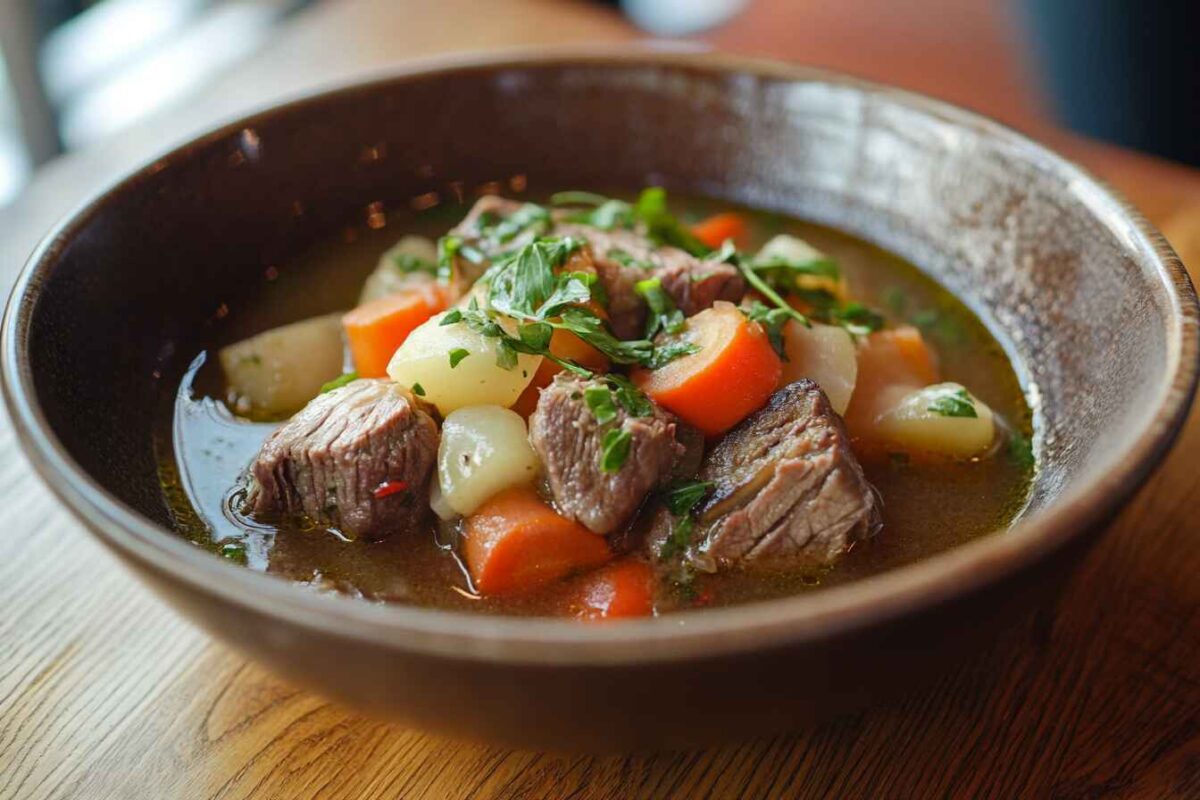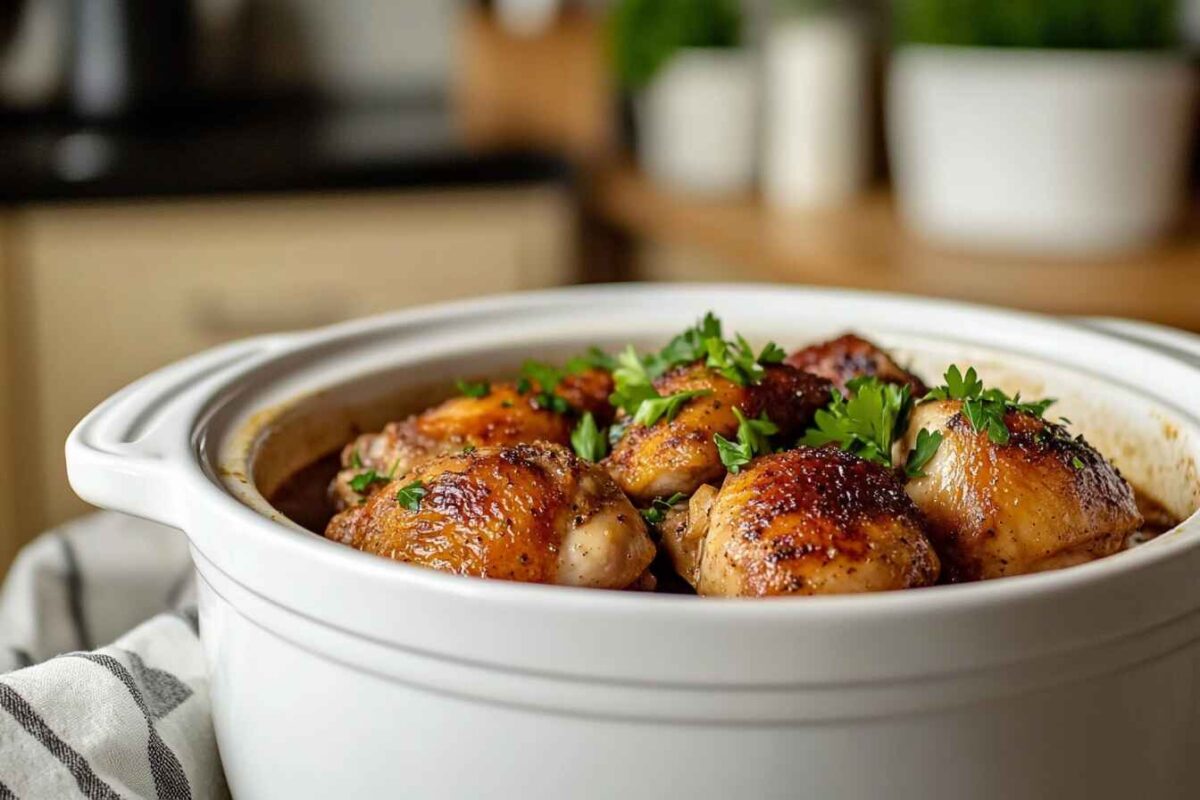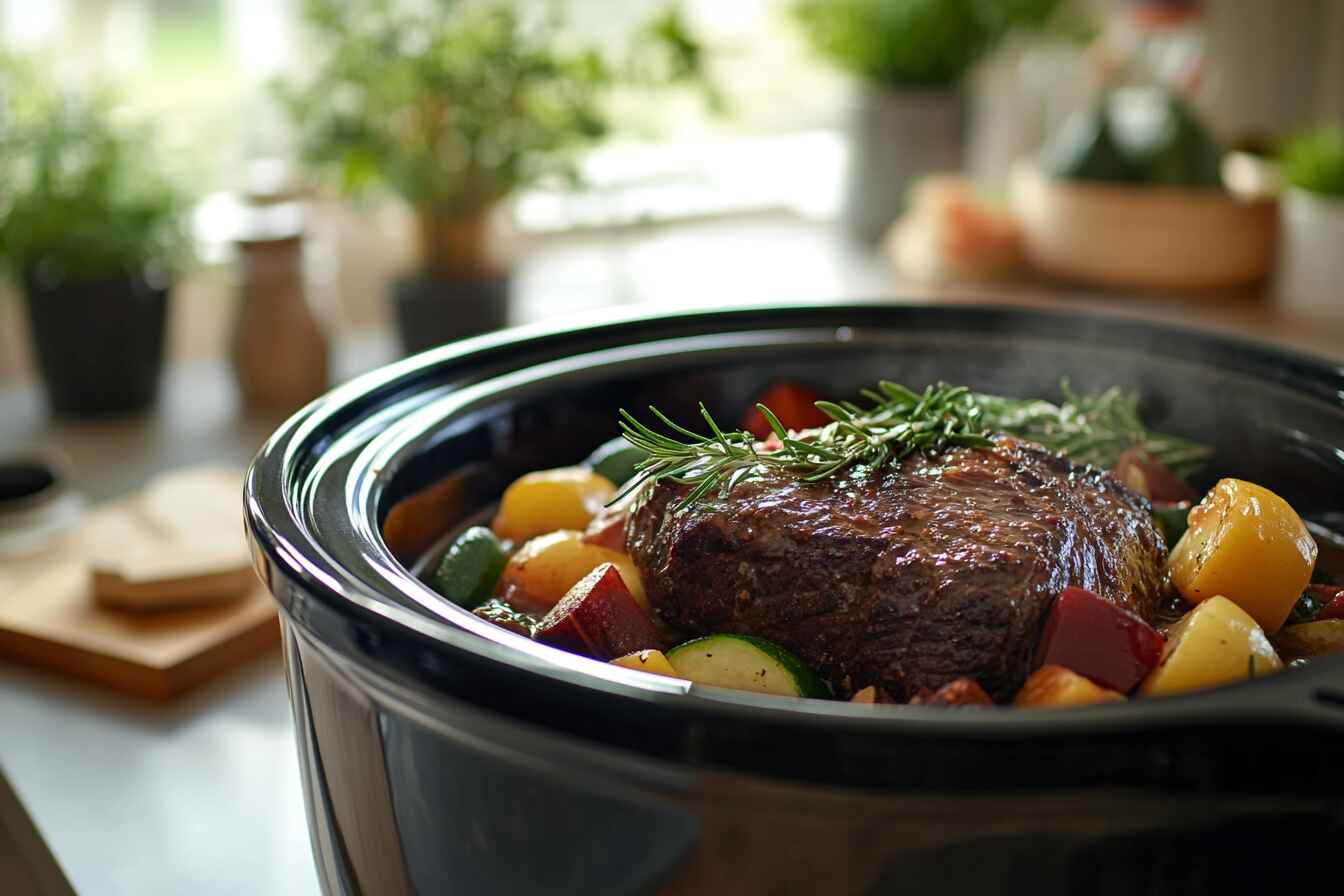Cooking with a Crockpot is like giving your ingredients a day at the spa they slow down, relax, and come out tasting better than ever. But what makes or breaks a Crockpot meal? You guessed it the meat! The right cut of meat can transform a dish from bland and boring to rich and flavorful. In this guide, we’ll dive into the best meat options for Crockpot meals, their unique advantages, and how to pick the perfect cut for your next culinary adventure. Let’s get cooking!
Table of Contents
What Is the Best Meat for Crockpot Meals?

Crockpot meals are like that favorite hoodie in your wardrobe reliable, versatile, and perfect for any time of year. On cold winter nights, there’s nothing more comforting than a warm, hearty beef stew simmering away. In the heat of summer, a light and zesty shredded chicken taco filling prepared in your Crockpot keeps the kitchen cool and the flavors fresh. The best part? A Crockpot doesn’t require constant attention, leaving you free to focus on other things while it works its magic.
Benefits of Using a Crockpot for Cooking Meat
Retains Juiciness and Flavor
Have you ever bitten into a piece of meat and thought, “Wow, this is so dry it’s practically jerky”? That won’t happen with a Crockpot. Slow cooking locks in the juices, keeping the meat tender and flavorful. The low heat allows the natural fats and juices to distribute evenly, creating a mouthwatering result.
Tenderizes Tough Cuts of Meat
Some meats are like that one friend who takes forever to warm up to new people they need time to shine. Cuts like chuck roast or lamb shanks are tough initially, but when you let them slow-cook in a Crockpot, they soften into something heavenly. The long, slow cooking process breaks down collagen and connective tissues, leaving you with tender, fall-apart meat.
Convenient and Time-Saving
If you’re juggling work, school, or family life, a Crockpot is your best friend. It’s the ultimate “set it and forget it” kitchen tool. Toss your ingredients in the pot in the morning, go about your day, and come home to a meal that smells and tastes like you spent hours cooking. Convenience level: 100.
Understanding the Different Types of Meat for Crockpot Meals
Choosing the right meat for your Crockpot dish is like choosing the perfect pair of shoes it depends on the occasion. Let’s break down the best options:
Beef Cuts Suitable for Slow Cooking
Beef is a Crockpot classic. Cuts like chuck roast, brisket, and short ribs are stars in the slow-cooking universe. Their marbling and connective tissue make them ideal for hours of low-and-slow cooking. By the time they’re done, they’re melt-in-your-mouth delicious.
Chicken Options for Crockpot Meals

Chicken is a versatile option for Crockpot meals. Thighs are particularly great because they stay juicy even after hours of cooking. Whole chickens are a cost-effective option, while chicken breasts require careful monitoring to avoid drying out.
Lamb and Other Meat Choices for Crockpots
Looking for something a little different? Lamb shanks or even venison can take your Crockpot meals to the next level. These meats require slow cooking to soften their robust fibers, resulting in rich and unique flavors that are worth the wait.
“The right cut of meat isn’t just an ingredient; it’s the soul of your Crockpot meal. Choose wisely, and your dish will sing.”
Key Factors in Choosing the Best Meat for Crockpot Meals
Fat Content and Marbling
Fat is flavor there’s no getting around it. Cuts with good marbling, like chuck roast or pork shoulder, render their fat into the dish as they cook, adding depth and richness to the flavor. Leaner cuts can work too, but they often need a little help from broths, sauces, or marinades.
Bone-In vs. Boneless Cuts
Ever notice how soups and stews made with bone-in meat taste richer? Bones release collagen and flavor during cooking, adding complexity to the dish. While boneless cuts are easier to handle, bone-in options often provide a more robust taste.
Fresh vs. Frozen Meat
Here’s the million-dollar question: Can you put frozen meat in a Crockpot? The answer is yes, but with a caveat. It’s safer to thaw your meat first to ensure even cooking. Frozen meat can take longer to reach safe temperatures, which might leave it in the “danger zone” for bacteria for too long.
Beef for Crockpot Meals: A Closer Look
Why Chuck Roast Is the King of Crockpot Beef
When it comes to beef, chuck roast reigns supreme. This cut is full of marbling and connective tissues that break down during cooking, turning into a tender, flavorful masterpiece. It’s perfect for classic pot roast or shredded beef tacos.
Brisket: A Flavorful Alternative
If you’re looking for something with a little more bite, brisket is a great choice. Its firm texture holds up well in recipes that require long cooking times. Think BBQ brisket or hearty beef stews.
Short Ribs: Adding Richness to Slow-Cooked Dishes
Short ribs are the unsung heroes of Crockpot cooking. Their high fat content and bone structure make them a flavorful addition to soups, stews, or even as the main attraction in a red wine-braised dish.
Chicken for Crockpot Meals: Options to Consider
Chicken is like the Swiss Army knife of Crockpot meats versatile, budget-friendly, and easy to work with. Whether you’re whipping up a comforting chicken soup or a zesty shredded chicken for tacos, there’s a cut that fits the bill. Let’s dive into the best chicken choices for your Crockpot meals:
Boneless, Skinless Chicken Thighs: The Best Choice
When it comes to chicken in the Crockpot, thighs are the true MVPs. Why? Because they’re nearly impossible to overcook. Unlike chicken breasts, which can dry out quickly, thighs stay juicy and tender even after hours of slow cooking. They’re packed with flavor, especially if you leave a bit of fat on them. Whether you’re making a creamy chicken curry or a simple garlic herb chicken, thighs won’t disappoint.
Whole Chicken: A Cost-Effective Solution
Cooking a whole chicken in the Crockpot might sound intimidating, but it’s surprisingly easy. Plus, it’s one of the most budget-friendly ways to feed a crowd. The slow cooker transforms the bird into a tender, juicy masterpiece while the bones release collagen and flavor into the broth. Add some carrots, onions, and celery, and you’ve got a meal that’s as nourishing as it is delicious. Pro tip: Save the leftover bones for homemade chicken stock!
Chicken Breasts: Pros and Cons
Chicken breasts are a popular choice for Crockpot meals, but they’re a bit of a wild card. On the one hand, they’re lean and high in protein, making them a healthy option. On the other hand, they’re prone to drying out if cooked too long. To get the best results, use plenty of liquid (like broth or sauce) and aim for a cooking time of no more than 4-6 hours on low heat.
Lamb and Game Meat for Unique Crockpot Recipes
Sometimes, you just want to break out of the usual beef-chicken-pork routine. That’s where lamb and game meats come in. These options might not be everyday staples, but they can add a touch of elegance and adventure to your Crockpot meals.
Lamb Shanks: A Gourmet Choice
Lamb shanks are made for slow cooking. Their tough connective tissues break down over time, creating a dish that’s rich, tender, and bursting with flavor. Whether you’re making a classic lamb stew or an exotic Moroccan-inspired tagine, shanks will take your Crockpot game to the next level.
Venison and Other Game Meats for a Rustic Twist
If you’ve got access to venison, elk, or other game meats, don’t hesitate to toss them into your Crockpot. These meats are naturally lean, so they benefit from the slow-cooking process, which tenderizes them and enhances their earthy flavors. Pair them with bold spices and hearty vegetables for a rustic, crowd-pleasing meal.
“Experimenting with unconventional meats like lamb or venison can turn a simple Crockpot meal into an unforgettable culinary adventure.”
Common Mistakes to Avoid When Choosing Meat for Crockpot Meals
Even the best intentions can go awry if you don’t know the pitfalls to avoid. Here are some common mistakes people make when selecting and preparing meat for their Crockpot meals:
Using Lean Cuts Without Adjustments
Lean cuts like chicken breasts or pork loin are tricky in a Crockpot. Without enough fat or liquid, they can end up dry and unappetizing. The fix? Always add a generous amount of broth, sauce, or fat (like butter or oil) to keep them moist.
Overcrowding the Crockpot
Your Crockpot is not a clown car don’t try to cram too much in! Overcrowding prevents the heat from circulating properly, which can lead to uneven cooking. Make sure there’s enough room for the meat to sit in a single layer or at least have some space to “breathe.”
Not Prepping Meat Properly
Prepping your meat is essential for a successful Crockpot dish. For beef or pork, searing the meat beforehand can add a depth of flavor you’ll miss if you skip this step. For chicken, trimming excess fat and skin can help avoid a greasy texture in the final dish.
Enhancing Crockpot Meals with Perfect Seasoning
Seasoning is the unsung hero of any Crockpot meal. A well-seasoned dish can make even the simplest cuts of meat taste gourmet. Here’s how to get it right:
Balancing Spices with Meat Cuts
Some meats have bold flavors that pair well with strong spices, while others need a lighter touch. For example, lamb shanks love warming spices like cinnamon and cumin, while chicken thighs shine with garlic, lemon, and rosemary.
The Importance of Liquid Ratios
In a Crockpot, liquid isn’t just about moisture it’s a flavor carrier. Too much liquid, and your dish turns into a soup. Too little, and the meat can dry out. A good rule of thumb is to add just enough liquid to cover the bottom of the Crockpot, allowing the meat’s natural juices to add to the mix as it cooks.
How to Use Broths and Marinades Effectively
Broths and marinades are your flavor powerhouses. Beef broth can add depth to a pot roast, while a zesty citrus marinade can brighten up chicken thighs. Just be mindful of salt levels some store-bought broths and marinades can be quite salty, so adjust your seasoning accordingly.
How to Store and Reheat Crockpot Meals with Meat
Leftovers? Yes, please! Crockpot meals often taste even better the next day, as the flavors continue to meld. Here’s how to store and reheat them without losing quality:
Safe Storage Tips for Leftovers
First, let your Crockpot meal cool to room temperature before transferring it to an airtight container. Store it in the fridge if you plan to eat it within 3-4 days, or freeze it for longer storage (up to 3 months).
Reheating Without Losing Flavor
When reheating, avoid the microwave if possible it can dry out your meat. Instead, use a stovetop or oven with a splash of broth or water to maintain moisture. If you must use a microwave, cover the dish with a damp paper towel to help lock in moisture.
Popular Crockpot Meat Recipes to Try
If all this talk of Crockpot meals has your stomach rumbling, here are a few tried-and-true recipes to get you started:
Classic Pot Roast Recipe
- Ingredients: Chuck roast, potatoes, carrot
FAQs About Choosing the Best Meat for Crockpot Meals
Can I use frozen meat in the Crockpot?
Yes, you can use frozen meat in the Crockpot, but it’s safer to thaw it first. Starting with frozen meat can delay the time it takes to reach a safe cooking temperature, increasing the risk of bacteria growth. If you decide to cook frozen meat, make sure the Crockpot is set to high for the first hour and that the meat reaches the recommended internal temperature.
What are the best spices for Crockpot meat dishes?
The best spices depend on the type of meat you’re using. For beef, spices like garlic, rosemary, thyme, and paprika work wonders. Pork pairs beautifully with smoky flavors like cumin, smoked paprika, and BBQ blends. Chicken is versatile and shines with lighter spices like oregano, lemon pepper, or curry blends. Don’t forget salt and pepper they’re essential for bringing out the natural flavors of the meat.
How do I keep meat from drying out in a Crockpot?
To keep meat juicy, make sure to include enough liquid in your recipe, such as broth, water, or sauce. Fatty cuts of meat like chuck roast or chicken thighs naturally retain moisture better than lean cuts. If you’re using lean meat like chicken breasts, consider adding extra fats like butter or olive oil and avoid overcooking.
Can I find high-protein Crockpot recipes to try?
Yes! For a variety of delicious and healthy high-protein Crockpot recipes, check out Majestic Recipes’ Slow Cooker Secrets. These recipes are perfect for those looking to combine flavor and nutrition in their slow-cooked meals.
Choosing the Best Meat for Crockpot Meals
Choosing the best meat for Crockpot meals isn’t just about following a recipe it’s about understanding how different cuts of meat interact with the slow-cooking process. Whether it’s the marbled richness of chuck roast, the juicy tenderness of chicken thighs, or the rustic flavors of lamb shanks, every cut brings its own magic to the Crockpot. The key is to match the right meat with the right seasonings, liquids, and cooking time.

